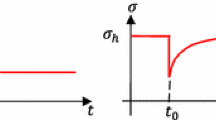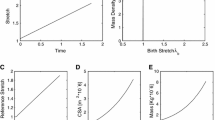Abstract
Soft tissues grow and remodel in response to mechanical loading. In this work soft tissue is modeled as a homogeneous mixture of two constituents, namely elastin and collagen. It is assumed that elastin is neither produced nor removed and its mass remains constant, whereas collagen turns over depending on the stress in the tissue. A phenomenological continuum model is developed where the response of elastin is assumed to be viscoelastic. The response of collagen is assumed to be elastic.


Similar content being viewed by others
References
Jaalouk, D.E., Lammerding, J.: Mechanotransduction gone awry. Nat. Rev. Mol. Cell Biol. 10, 63–73 (2009)
Hsu, F.H.: The influences of mechanical loads on the form of a growing elastic body. J. Biomech. 1(4), 303–311 (1968)
Skalak, R.: Growth as a finite displacement field. IUTAM Symposium on Finite Elasticity, Martinus Nijhoff Publishers, The Netherlands (1981)
Fung, Y.C.: Biomechanics: Motion, Flow, Stress, Growth. Springer, New York (1990)
Rodriguez, E.K., Hoger, A., McCulloch, A.D.: Stress-dependent finite growth in soft elastic tissues. J. Biomech. 27(4), 455–467 (1994)
Menzel, A.: Modeling of anisotropic growth in biological tissues—a new approach and computational aspects. Biomech. Model Mechanobiol. 3(3), 147–171 (2005)
Menzel, A.: Anisotropic remodeling of biological tissues. In: Holzapfel, G.A., Ogden, R.W. (eds.) Mechanics of Biological Tissue, pp. 91–104. Springer, Berlin (2006)
Preziosi, L., Tosin, A.: Multiphase modelling of tumour growth and extracellular matrix interaction: mathematical tools and applications. J. Math. Biol 58, 625–656 (2009)
Ateshian, G.A.: On the theory of reactive mixtures for modeling biological growth. Biomech. Model Mechanobiol. 6(6), 1–39 (2007)
Cowin, S.C., Cardoso, L.: Mixture theory-based poroelasticity as a model of interstitial tissue growth. Mech. Mater. 44, 47–57 (2012)
Humphrey, J.D., Rajagopal, K.R.: A constrained mixture model for growth and remodeling of soft tissues. Math. Models Methods Appl. Sci. 12, 407–430 (2002)
Baek, S., Rajagopal, K.R., Humphrey, J.D.: A theoretical model of enlarging intracranial fusiform aneurysms. J. Biomech. Eng. 128, 142–149 (2006)
Na, S., Meininger, G.A., Humphrey, J.D.: A theoretical model for f-actin remodeling in vascular smooth muscle cells subjected to cyclic stretch. J. Theoret. Biol. 246, 87–99 (2007)
Gleason, R.L., Humphrey, J.D.: A mixture model of arterial growth and remodeling in hypertension: altered muscle tone and tissue turnover. J. Vasc. Res. 41, 352–363 (2004)
Gleason, R.L., Humphrey, J.D.: Effects of a sustained extension on arterial growth and remodeling: a theoretical study. J. Biomech. 38, 1255–1261 (2005)
Valentin, A., Humphrey, J.D.: Evaluation of fundamental hypotheses underlying constrained mixture models of arterial growth and remodelling. Phil. Trans. R. Phi. A 367, 3585–3606 (2009)
Thorne, B.C., Hayenga, H.N., Humphrey, J.D., Peirce, S.M.: Toward a multi-scale computational model of arterial adaptation in hypertension: verification of a multi-cell agent based model. Front. Physiol. 2(20), 1–12 (2011)
Rao, I.J., Rajagopal, K.R., Humphrey, J.D.: Biological growth and remodeling: a uniaxial example with possible application to tendons and ligaments. CMES 4, 439–455 (2003)
Ravindran, P., Kannan, K.: A study of growth and remodeling in soft tissues. Int. J. Adv. Eng. Sci. Appl. Math. 3, 106–110 (2011)
Mythravaruni, P., Ravindran, P.: A constitutive model for soft tissue and its application to a boundary value problem. ASME, San Diego, California, USA (2013)
McAnulty, L.: Collagen synthesis and degradation in vivo. evidence for rapid rates of collagen turnover with extensive degradation of newly synthesized collagen in tissues of the adult rat. Collagen Relat. Res. 7(2), 93–104 (1987)
Markus, J.B., Sophie, Y.W.: Entropic elasticity controls nanomechanics of single tropocollagen molecules. Biophys. J. 93(1), 37–43 (2007)
Lillie, M.A., Gosline, J.M.: The effects of hydration on the dynamic mechanical properties of elastin. Biopolymers 29, 1147–1160 (1990)
Lillie, M.A., Gosline, J.M.: The viscoelastic basis for the tensile strength of elastin. Int. J. Biol. Macromol. 30, 119–127 (2002)
Rajagopal, K.R., Srinivasa, A.R.: A thermodynamic frame work for rate type fluid models. J. Non Newton. Fluid Mech. 88, 207–227 (2000)
Rajagopal, K.R., Tao, L.: Mechanics of Mixtures, Series on Advances in Mathematics for Applied Sciences, vol. 35. World Scientfic, Singapore (1995)
Taber, L.A.: Biomechanics of growth, remodeling and morphogenesis. Appl. Mech. Rev. 48, 487–545 (1995)
Lefevre, M., Rucker, R.B.: Aorta elastin turnover in normal and hypercholesterolemic japanese quail. Biochemica et Biophysica Acta 630(4), 519–529 (1980)
Kannan, K., Rajagopal, K.R.: A thermodynamic framework for the transition of viscoelastic liquid to a viscoelastic solid. Math. Mech. Solids 9(1), 37 (2004)
Author information
Authors and Affiliations
Corresponding author
Rights and permissions
About this article
Cite this article
Mythravaruni, P., Ravindran, P. Growth and remodeling in soft tissues subjected to torsion. Int J Adv Eng Sci Appl Math 8, 39–45 (2016). https://doi.org/10.1007/s12572-016-0162-5
Published:
Issue Date:
DOI: https://doi.org/10.1007/s12572-016-0162-5




